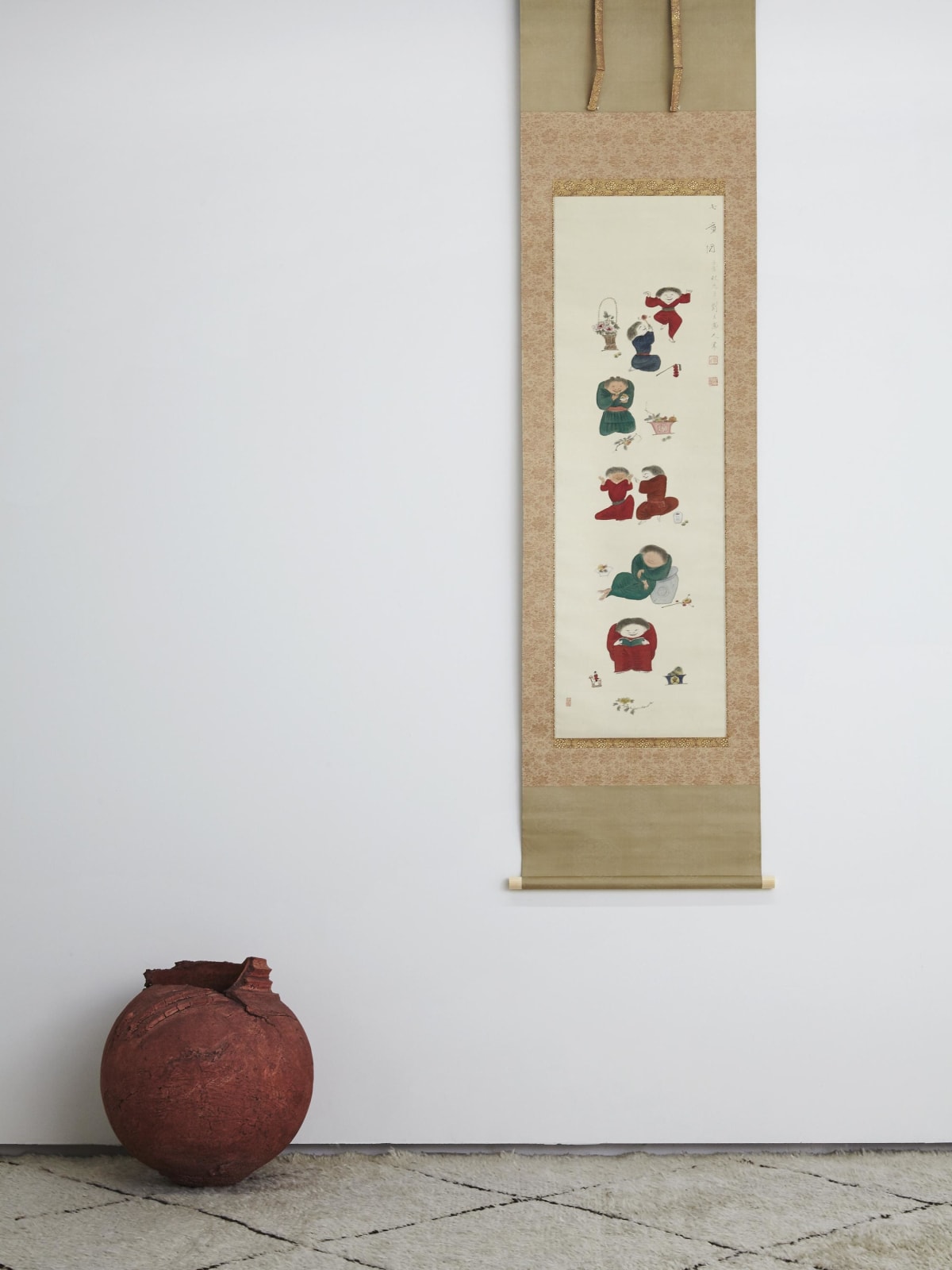Kishida Ryūsei (1891–1929)
Seven Children
Color on silk, hanging scroll
Titled by the artist
Dated 1922
With a certificate of Ryusei no kai and authentication by Kimura Shohachi,
box authentication by Kimura Shohachi, double boxed
Seals: Ryusei; Kishidashi in; Takkai banko shimpo
110.3 x 34.8 cm
195 x 48 cm (overall)
Titled by the artist
Dated 1922
With a certificate of Ryusei no kai and authentication by Kimura Shohachi,
box authentication by Kimura Shohachi, double boxed
Seals: Ryusei; Kishidashi in; Takkai banko shimpo
110.3 x 34.8 cm
195 x 48 cm (overall)
Further images
Exhibitions
Kishida Ryusei nihonga tenrankai. Tokyo: Kenkado, 1922.Seienkaku exhibition. Sakata: Homma Museum of Art, 1950.
Kishida Ryusei ten. Fukui: Fukui Fine Arts Museum; Kumamoto: Kumamoto Prefectural Museum of Art; Nishinomiya: Otani Memorial Art Museum, 1988. cat. no. 75.
The inscription of this work, “Seven Boys: Ryusei gajin painted in autumn, September, 1922” indicates that Kishida Ryusei composed it at the age of thirty-one. Ryusei got his hand in the practice of nihonga in around 1921. The present work might be intended for his solo exhibition Nihonga tenrankai taken place in the following month after its execution.
Ryusei was particularly interested in Chinese paintings at the time. In this painting, a somewhat Chinoiserie style is found in the appearance of the boys, the color glazed pots inscribed with “ryu” or “do”, and the celadon container against which a boy laid. However, the representations of the flowers, fruits, confectionaries, pellet drums, and the skewered lanterns are of Japanese folk craft style. A sense of familiarity is infused with the exoticism in this work. It seems that Ryusei composed the present work based on basic forms, such as circle, triangle and rectangle, consciously or unconsciously.
Kishida Ryusei (yoga painter; 1891–1929)
Tokyo-born yoga painter; son of the enterpriser Kishida Ginko. Student of Kuroda Seiki at Hakubakai yoga kenkyu-jo (Western art institute of the white horse society). Gained influence from the literary journal Shirakaba, and became close to figures such as Mushakoji Saneatsu. Co-founded Fusain-kai with Saito Yori and Kimura Shohachi. Later vitalized Sodo-sha. Established his own style through landscape, still-life and portrait series of his own daughter Reiko. Interested in early hand-painted ukiyo-e paintings, and Song and Yuan dynasty paintings. Also practised nihonga.
Ryusei was particularly interested in Chinese paintings at the time. In this painting, a somewhat Chinoiserie style is found in the appearance of the boys, the color glazed pots inscribed with “ryu” or “do”, and the celadon container against which a boy laid. However, the representations of the flowers, fruits, confectionaries, pellet drums, and the skewered lanterns are of Japanese folk craft style. A sense of familiarity is infused with the exoticism in this work. It seems that Ryusei composed the present work based on basic forms, such as circle, triangle and rectangle, consciously or unconsciously.
Kishida Ryusei (yoga painter; 1891–1929)
Tokyo-born yoga painter; son of the enterpriser Kishida Ginko. Student of Kuroda Seiki at Hakubakai yoga kenkyu-jo (Western art institute of the white horse society). Gained influence from the literary journal Shirakaba, and became close to figures such as Mushakoji Saneatsu. Co-founded Fusain-kai with Saito Yori and Kimura Shohachi. Later vitalized Sodo-sha. Established his own style through landscape, still-life and portrait series of his own daughter Reiko. Interested in early hand-painted ukiyo-e paintings, and Song and Yuan dynasty paintings. Also practised nihonga.













